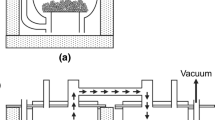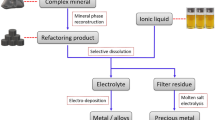Abstract
Available thermodynamic data applicable to copper smelting systems are collected and tabulated, and the important gaps are pointed out. A few examples are given of estimations which can be made from the available data. An experimental research program is proposed to supply the thermodynamic data that appear most essential to better quantitative understanding of the chemistry of copper smelting. The proposed program is designed also to shed specific light on the practical problems of slag losses and magnetite behavior.
Similar content being viewed by others
References
K. K. Kelley: Contributions to the Data on Theoretical Metallurgy. VII. The Thermodynamic Properties of Sulphur and Its Inorganic Compounds. U. S. Bur. Mines. Bull. 406 (1937).
P. Y. Huang and C. R. Hayward: Evidence of Formation of Copper Ferrite from Reaction between Cuprous Oxide and Copper Reverberatory Slags. Trans. AIME (1949) 182, 158–176: Met. Tech. (April 1947) TP 2140.
A. M. Aksoy: An Investigation of Copper Losses in Copper Reverberatory Slags. M.I.T. Sc.D. Thesis (1943).
E. A. Peretti: An Analysis of the Converting of Copper Matte. Discussions Faraday Soc. (1948) No. 4, 179–184.
L. S. Darken and R. W. Gurry: The System Iron-Oxygen. I. The Wustite Field and Related Equilibria. Jnl. Amer. Chem. Soc. (1945) 67, 1398–1412.
L. S. Darken and R. W. Gurry: The System Iron Oxygen. II. Equilibrium and Thermodynamics of Liquid Oxide and Other Phases. Jnl. Amer. Chem. Soc. (1946) 68, 798–816.
L. S. Darken: Melting Points of Iron Oxides on Silica; Phase Equilibria in the System Fe-Si-O as a Function of Gas Composition and Temperature. Jnl. Amer. Chem. Soc. (1948) 70, 2046–2053.
E. M. Cox, M. C. Bachelder, N. H. Nachtrieb, and A. S. Skapski: The Influence of Temperature on the Affinity of Sulphur for Copper, Manganese, and Iron. Trans. AIME, 184, 27–31; Jnl. of Met., Jan. 1949.
E. Maurer, G. Hammer, and H. Möbius: The Equilibrium between Iron and Hydrogen Sulphide. Arch. Eisenhutt. (1942) 16, 159–165.
A. J. Phillips: The Separation of Gases from Molten Metals. Trans. AIME (1947) 171, 17–46; Met. Tech. (June 1947) TP 2208.
N. L. Bowen and J. F. Schairer: The System, FeO-SiO. Amer. Jnl. Sci. (1932) 24, 177–213.
Metals Handbook. A.S.M. (1948).
C. B. Carpenter and C. R. Hayward: The Equilibrium Diagram of the System Cu23-FeS. Eng. and Min. Jnl. Press (1923) 115, 1055.
O. Reuleaux: Reaktionen und Gleichgewichte in System Cu-Fe-S mit besonderer Berücksichtigung des Kupfersteins. Met. und Erz. (1927) 24, 99–111.
H. E. Merwin and R. H. Lombard: The System Cu-Fe-S. Econ. Geol. (1937) 32, 203–284.
F. S. Wartman and G. L. Oldright: The Reaction Between Magnetite and Ferrous Sulphide. U. S. Bur. Mines. R.I. 2901 (1928).
Author information
Authors and Affiliations
Additional information
AIME New York Meeting, Feb. 1950.
TP 2868 D. Discussion (2 copies) may be sent to Transactions AIME before July 30, 1950.
Rights and permissions
About this article
Cite this article
Schuhmann, R. A survey of the thermodynamics of copper smelting. JOM 2, 873–884 (1950). https://doi.org/10.1007/BF03399077
Received:
Revised:
Published:
Issue Date:
DOI: https://doi.org/10.1007/BF03399077




